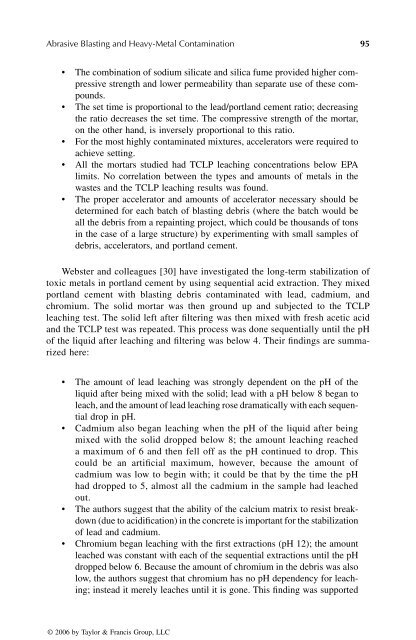© 2006 by Taylor & Francis Group, LLC
© 2006 by Taylor & Francis Group, LLC
© 2006 by Taylor & Francis Group, LLC
You also want an ePaper? Increase the reach of your titles
YUMPU automatically turns print PDFs into web optimized ePapers that Google loves.
Abrasive Blasting and Heavy-Metal Contamination 95<br />
• The combination of sodium silicate and silica fume provided higher compressive<br />
strength and lower permeability than separate use of these compounds.<br />
• The set time is proportional to the lead/portland cement ratio; decreasing<br />
the ratio decreases the set time. The compressive strength of the mortar,<br />
on the other hand, is inversely proportional to this ratio.<br />
• For the most highly contaminated mixtures, accelerators were required to<br />
achieve setting.<br />
• All the mortars studied had TCLP leaching concentrations below EPA<br />
limits. No correlation between the types and amounts of metals in the<br />
wastes and the TCLP leaching results was found.<br />
• The proper accelerator and amounts of accelerator necessary should be<br />
determined for each batch of blasting debris (where the batch would be<br />
all the debris from a repainting project, which could be thousands of tons<br />
in the case of a large structure) <strong>by</strong> experimenting with small samples of<br />
debris, accelerators, and portland cement.<br />
Webster and colleagues [30] have investigated the long-term stabilization of<br />
toxic metals in portland cement <strong>by</strong> using sequential acid extraction. They mixed<br />
portland cement with blasting debris contaminated with lead, cadmium, and<br />
chromium. The solid mortar was then ground up and subjected to the TCLP<br />
leaching test. The solid left after filtering was then mixed with fresh acetic acid<br />
and the TCLP test was repeated. This process was done sequentially until the pH<br />
of the liquid after leaching and filtering was below 4. Their findings are summarized<br />
here:<br />
• The amount of lead leaching was strongly dependent on the pH of the<br />
liquid after being mixed with the solid; lead with a pH below 8 began to<br />
leach, and the amount of lead leaching rose dramatically with each sequential<br />
drop in pH.<br />
• Cadmium also began leaching when the pH of the liquid after being<br />
mixed with the solid dropped below 8; the amount leaching reached<br />
a maximum of 6 and then fell off as the pH continued to drop. This<br />
could be an artificial maximum, however, because the amount of<br />
cadmium was low to begin with; it could be that <strong>by</strong> the time the pH<br />
had dropped to 5, almost all the cadmium in the sample had leached<br />
out.<br />
• The authors suggest that the ability of the calcium matrix to resist breakdown<br />
(due to acidification) in the concrete is important for the stabilization<br />
of lead and cadmium.<br />
• Chromium began leaching with the first extractions (pH 12); the amount<br />
leached was constant with each of the sequential extractions until the pH<br />
dropped below 6. Because the amount of chromium in the debris was also<br />
low, the authors suggest that chromium has no pH dependency for leaching;<br />
instead it merely leaches until it is gone. This finding was supported<br />
<strong>©</strong> <strong>2006</strong> <strong>by</strong> <strong>Taylor</strong> & <strong>Francis</strong> <strong>Group</strong>, <strong>LLC</strong>
















